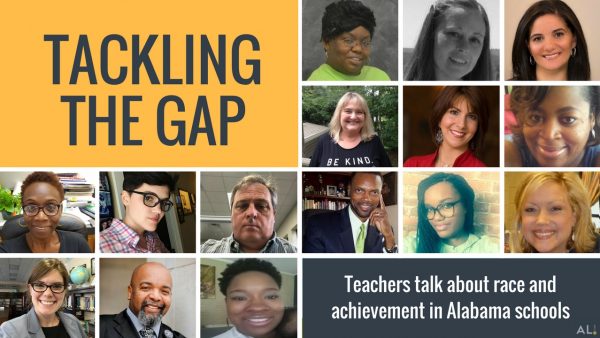Series Takes On Alabama’s Racial Achievement Gap
African-American students in Alabama tend not to perform as well on standardized tests as their white counterparts. That’s part of the so-called “achievement gap,” one of the most persistent and touchiest issues in education. But a new data-driven series by Al.com, journalism nonprofits Spaceship Media and Solutions Journalism Network, and teachers from across Alabama aims to address those disparities. Lead reporter Trisha Powell Crain of Al.com talks with WBHM’s Dan Carsen about the gap, and what teachers are trying to do about it.
The Gap They’re Fighting
“There’s always been this 20- to 30-percentage-point gap between black students and white students. And there are a lot of factors. … First you look at poverty — their parents may not have the resources to give them extra opportunities, to have books at home, to transport kids to after-school activities. But there are also school-based factors. We know that black kids and Hispanic kids are less likely to be identified as gifted. Why is that? It’s not the ‘raw material’ — that’s just not the case.”
One Factor
“In places where there is segregation, high [degrees of residential] segregation — all you have to do is look at Jefferson County and you see Vestavia and Homewood — there are often large achievement gaps. I mean they can almost predict where those achievement gaps are going to be. You have to identify the problem before you can address it.”
It’s Not Simple, Not the Kid
“I think that a large portion of the public thinks they have it figured out. They think they know why there is a racial achievement gap, and it boils down to, ‘oh, it’s just the kid,’ which, research shows, it’s not the kid. But when people already think they know the answer, it’s kind of hard to present to readers that, no, it’s actually this, plus this, plus this, plus this, plus this. And the ones who want to simplify it, I think it’s a way of pushing it off to the side and saying ‘that’s not my problem.'”
Solutions?
“We’re starting to look at being very conscious about who you are identifying for [disciplining and] for gifted opportunities, being very conscious about supporting children, taking them where they are, and being deliberate in who you offer resources to. I mean, when you think about it, there’s one teacher in front of 20 kids, sometimes 30 kids, sometimes 35. So a teacher has to figure out, ‘how am I going to divide up my time? Who am I going to help? Who am I going to pay attention to?’ [Also,] are there wraparound services?’ We know in community schools where there are wraparound services available to help kids with all of that stuff outside of the school day, the children learn better. We aren’t doing that much in Alabama.”
Q&A: How harm reduction can help mitigate the opioid crisis
Maia Szalavitz discusses harm reduction's effectiveness against drug addiction, how punitive policies can hurt people who need pain medication and more.
The Gulf States Newsroom is hiring a Community Engagement Producer
The Gulf States Newsroom is seeking a curious, creative and collaborative professional to work with our regional team to build up engaged journalism efforts.
Gambling bills face uncertain future in the Alabama legislature
This year looked to be different for lottery and gambling legislation, which has fallen short for years in the Alabama legislature. But this week, with only a handful of meeting days left, competing House and Senate proposals were sent to a conference committee to work out differences.
Alabama’s racial, ethnic health disparities are ‘more severe’ than other states, report says
Data from the Commonwealth Fund show that the quality of care people receive and their health outcomes worsened because of the COVID-19 pandemic.
What’s your favorite thing about Alabama?
That's the question we put to those at our recent News and Brews community pop-ups at Hop City and Saturn in Birmingham.
Q&A: A former New Orleans police chief says it’s time the U.S. changes its marijuana policy
Ronal Serpas is one of 32 law enforcement leaders who signed a letter sent to President Biden in support of moving marijuana to a Schedule III drug.








